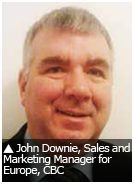Sending Data across Far Distances
While the size of the farm determines the type of security required, the level of security deployed establishes the type of transmission used. “It can be completely wireless, or it can run on copper or fiber from the farm to the central station and then to the cloud. Because the farm itself is a closed segment, it can receive an adequate amount of bandwidth; however, it must be rationed carefully between all the first responders who are expecting to receive data,” Scifers said.
Farms selecting the right communication and transmission solution should consider the distance, site location, telecommunication status in the area and their budget, said Ippazio Martella, President of Marss.
Many of the sites that will be constructed or have recently been completed are built with a communication plan. “Wires are needed to carry the electricity from the grid to the station, and the same infrastructure can be used for communication,” Katz said.
 The electronic devices themselves rely on a number of transmission methods to deliver data to monitoring stations or to each other. “Copper cables, fiber-optic cabling and wireless are all being used,” Downie said. “Radar units, for example, can be wireless and solar- or wind-powered so they can be positioned almost anywhere with no need to dig up the site. Whichever transmission method is chosen, the system's operating parameters should ensure full functionality in terms of image and data output rate.”
The electronic devices themselves rely on a number of transmission methods to deliver data to monitoring stations or to each other. “Copper cables, fiber-optic cabling and wireless are all being used,” Downie said. “Radar units, for example, can be wireless and solar- or wind-powered so they can be positioned almost anywhere with no need to dig up the site. Whichever transmission method is chosen, the system's operating parameters should ensure full functionality in terms of image and data output rate.”
However,wireless is more prone to interference compared to wired transmission. “Just as some cellphone calls drop, wireless transmission can be problematic if the wind farms are in remote locations," Putnam said. “Wired transmission is more reliable and since wires are already in place for the transmission of electricity, it is a preferable option."
Environmental Considerations
The hot sun and harsh winds are what optimize a solar or wind farm's energy productivity. However, they can pose a problem for the equipment deployed in these areas. “It is important that the selected security system resists the weather and the environmental stress, which are very strong and can affect the operation of the system,” Martella said. “One must keep in mind that the system must run properly 24/7.”
To overcome the harsh environment, electronic components are shielded within appropriate hard-casing enclosures and designed to ensure noninterference with the energy-generating systems' electronic circuitry, Downie said.
A clear LOS is necessary for radars to work effectively. “Luckily, solar farms are isolated and rarely have tall structures surrounding them,” Scifers said.
R&D efforts are also in place to maximize the range of the radars. “Currently, the largest radius for such applications is 1,600 meters,” Avery said. Longer-range radars and a clear LOS would require fewer devices to sufficiently protect a large area.
Security measures for solar and wind farms differ from residential or commercial sites. “Some places are trying to force small-area solutions to fit a wide-area problem. It simply will not work,” Scifers said. “Proper consideration to the site has to be made, and the solution should be tailored to it.” As the market for renewable energy expands, so will the necessary knowledge required to protect and ensure the smooth operation at sustainable power farms.